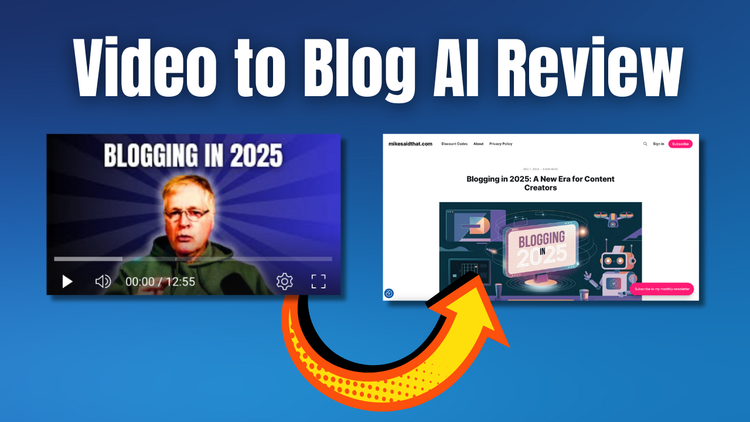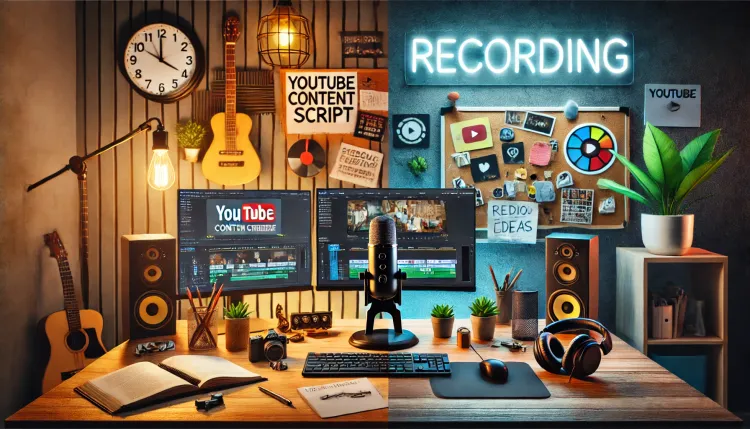Why Is My YouTube Channel Watch Time Decreasing?

Ever wondered why your YouTube channel's watch time is going down? This can be a big mystery for creators, even if they keep uploading videos. It's important to know why watch time is dropping to help your channel grow and succeed online.
YouTube's algorithm uses watch time to figure out which videos to show first and suggest next. As a creator, understanding how watch time works is key to doing well. Let's look at why watch time changes and how to get more viewers to stick around. I've experienced this phenomena when I've released two or three videos in a row that didn't resonate with viewers. It can have an adverse effect on future videos and it can be disheartening.
Key Takeaways
- Watch time is a big deal for YouTube's algorithm in deciding which videos to show and suggest
- Changes in your content or quality can cause watch time to drop suddenly, which may affect your YouTube views.
- Seasonal changes might affect watch time for some types of videos
- Checking your channel's performance with YouTube Analytics is important to find problems
- Keeping up with content and engaging with your audience helps improve watch time, which is crucial for every YouTuber.
Understanding YouTube Watch Time and Its Importance
Watch time is a key metric in YouTube analytics. It shows how long a viewer watches a video, contributing to the overall watch time. This is important for growing your channel and making money.
Definition of Watch Time
Watch time is the total time viewers spend watching your videos on YouTube. It's not just about how many people see your video. It's about how engaged they are. The longer people watch, the higher the watch time. This is key for creators who want to grow their channels and reach more people.
Impact on Channel Growth and Monetization
Watch time helps your channel grow. Videos with more watch time get recommended by the youtube algorithm. This means more people see your videos and you might get more subscribers. To make money, you need 4,000 hours of watch time and 1,000 subscribers in the last year.
How YouTube's Algorithm Uses Watch Time
The YouTube algorithm uses watch time a lot to decide which videos to show and recommend. Videos with more watch time are seen as more engaging. This means they get shown to more people. So, more watch time means more recommendations, which helps your channel grow.
| Metric | Understanding the impact on the algorithm can help creators on YouTube improve their content strategy. |
|---|---|
| Total Watch Time | Primary ranking factor |
| Average View Duration | Influences video recommendations |
| Session Watch Time | Affects video visibility |
Getting good at watch time is key for doing well on YouTube. By making engaging content and checking your YouTube analytics, you can increase your watch time. This helps your channel grow and opens up more ways to make money.
Common Causes of Decreasing Watch Time
A drop in watch time can be frustrating for YouTube creators. It's important to know why this happens to keep viewers coming back. Let's look at some reasons why your watch time might be going down.
How good your content is plays a big part in keeping viewers around. If your recent videos aren't as good as before, people might not stick around. This can lead to fewer views and shorter watch times.
How often you post is also key. Posting too little or too much can make people lose interest. Try to post new videos regularly to keep your viewers interested and coming back.
- Shifting audience preferences
- Increased competition in your niche
- Seasonal fluctuations in viewer behavior
- Algorithm changes affecting video recommendations
- Technical issues with video playback
To stop your watch time from going down, think about changing your content strategy. Make videos that really speak to your audience and keep them watching. Look at your best videos to see what makes them so popular.
| Factor | Impact on Watch Time | Recommended Action |
|---|---|---|
| Content Quality | High | Improve production value and relevance |
| Upload Frequency | Medium | Maintain consistent posting schedule |
| Audience Engagement | High | Encourage comments and interaction |
| Video Length | Medium | Optimize for viewer preferences |
| Thumbnails and Titles | Medium | Create compelling, accurate previews |
By looking at these factors and making changes, you can try to increase your watch time. This will help improve your channel's performance.
Why Is My YouTube Watch Time Decreasing?
Seeing a drop in watch time on your YouTube channel can be worrying. It's important to understand why this is happening to fix the problem.
Sudden vs. Gradual Decline
A quick fall in watch time usually means there's a clear reason. This could be a single video not doing well or changes in how your videos are shown. A slow decline might suggest bigger problems with your content or how you connect with viewers.
Single Video Impact vs. Channel-Wide Issue
Figure out if the drop in watch time is just for one video or your whole channel. A copyright issue with a popular video can really hurt your overall watch time. Also, if some videos are set to private, it can also hurt your numbers.
Changes in Content Strategy or Quality
Look back to when your watch time started going down. See if you made any changes like new thumbnails or video features. Trying new things is good, but stick with what your audience likes best.
Seasonal Fluctuations
Some types of content do better at certain times of the year. For example, holiday content might get more views during holidays. Knowing these patterns can help you plan your content better.
YouTube needs 4,000 watch hours in a year to make money. Making consistent content, engaging with your audience, and keeping viewers coming back are key to boosting watch time naturally.
Analyzing Your Channel's Performance
To figure out why your YouTube channel's watch time is dropping, you need to look closely at your channel's performance. YouTube analytics gives you key insights. These help you spot trends and patterns in how your content does.
Using YouTube Analytics
YouTube analytics is super helpful for tracking watch time trends. It shows you how engaged your viewers are. This lets you see which videos are hits and which ones aren't doing well. Keep an eye on average view duration and how well your audience stays with your content.
Visibility Settings and Copyright Claims
Make sure all your videos are set to be public. Sometimes, they might be accidentally made private or unlisted, hurting your watch time. Also, check for any copyright claims on your videos. These can affect how people see your content and if you can make money from it.
Subscriber vs. Non-Subscriber Watch Time
Look at how much time subscribers and non-subscribers spend watching your videos. Subscribers usually watch your videos twice as long as others. If you see a big drop in subscriber watch time, it might mean your content isn't hitting the mark with your main audience.
Upload Frequency Assessment
Upload frequency doesn't directly affect growth in views, but a steady schedule keeps your audience coming back. See how changing how often you upload affects your watch time. Remember, the quality of your content is more important than how much you upload.
| Metric | Average Range | Impact on Performance |
|---|---|---|
| Impression Click-Through Rate (CTR) | 2% - 10% | Higher CTR means more engaging thumbnails and titles |
| Retention Rate | 50% - 60% | Higher retention means your content is more engaging |
| Subscriber Watch Time | 2x non-subscriber watch time | More watch time from subscribers shows a loyal audience |
By looking closely at these parts of your channel's performance, you can find areas to improve. This will help you come up with strategies to increase your YouTube watch time.
Conclusion
Understanding YouTube watch time and channel growth is complex. The YouTube algorithm looks at how engaged viewers are to see your content. With an average view time of 1 minute and 31 seconds, making content that keeps viewers hooked is crucial.
To fight the drop in watch time, creators should check their channel's performance often. YouTube Analytics gives key insights into how viewers act. This helps creators spot trends and improve their content to match what viewers like.
Being consistent is vital for keeping and growing watch time. Data shows that 25% of top channels have been around for 5-10 years. Creators should stick to a regular schedule and offer a variety of content to keep viewers interested. Keeping up with YouTube's best practices and algorithm changes helps creators boost watch time and grow their channel sustainably.
Frequently Asked Questions
Q: Why is my YouTube channel watch time decreasing suddenly?
A: Sudden decreases in watch time can happen for various reasons. It could be due to changes in the YouTube algorithm, seasonal fluctuations in viewership, or changes in your content strategy. It's important to analyze your channel analytics in YouTube Studio to diagnose the specific cause and take appropriate action.
Q: How can I optimize my YouTube videos to increase watch time?
A: To optimize your videos and increase watch time, focus on creating engaging content, use eye-catching thumbnails, write compelling titles, and implement SEO best practices. Additionally, create longer videos (if appropriate for your content), use end screens to encourage viewers to watch more of your content, and ensure your content aligns with your audience's interests.
Q: Can changes in my upload schedule affect my YouTube channel's watch time?
A: Yes, changes in your upload schedule can significantly impact your channel's watch time. Consistency is key for maintaining and growing your audience. If you've changed your upload frequency or timing, it may affect your viewers' habits and expectations, potentially leading to a decrease in watch time.
Q: How does the YouTube algorithm affect watch time?
A: The YouTube algorithm plays a crucial role in determining video recommendations and search results, which can directly impact your watch time. The algorithm favors videos with higher engagement rates, including watch time. If your videos aren't performing well in terms of watch time, the algorithm may recommend them less frequently, leading to a decrease in overall channel watch time.
Q: Is a decrease in watch time limited to a single video or does it affect my entire YouTube channel?
A: A decrease in watch time can affect either individual videos or your entire channel, depending on the cause. If the issue is limited to a single video, it might be due to that specific content not resonating with your audience. However, if you're noticing a drop in watch time across multiple videos, it could indicate a broader issue affecting your entire channel.
Q: How can collaborating with other YouTubers help increase my channel's watch time?
A: Collaborating with other YouTubers can expose your content to new audiences, potentially increasing your watch time. When you collaborate, you can cross-promote each other's channels, which may lead to new subscribers and increased viewership. Additionally, collaborative content often tends to be more engaging, which can result in longer watch times.
Q: What tools can I use to gain insights into my YouTube channel's watch time?
A: YouTube Studio is the primary tool for analyzing your channel's performance, including watch time. It provides detailed analytics on view counts, watch time, and audience retention. Additionally, third-party tools like TubeBuddy can offer extra insights and help you optimize your content for better performance.
Q: Should I contact YouTube if I notice a drastic decrease in my channel's watch time?
A: If you notice a sudden, drastic decrease in watch time that can't be explained by changes in your content or upload schedule, it may be worth contacting YouTube support. However, before doing so, thoroughly check your channel analytics, ensure there are no technical issues on your end, and review any recent changes to YouTube's policies that might affect your content.



